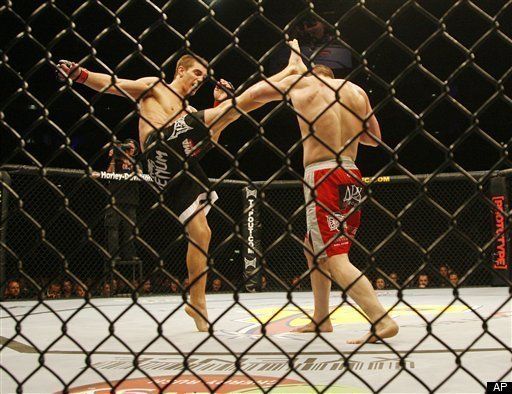
Recent media coverage of mixed martial arts has been uncharacteristically positive. So far in 2011, the sport, once referred to as human cockfighting, is credited for stopping an alleged mass murderer on the New York City subway and a robbery suspect in New Jersey.
For years, MMA athletes have claimed that their sport is not as primal as sometimes perceived by the untrained eye. Gym owners often open their doors to those who doubt the integrity and intricacy of the sport. They insist that respect and discipline, which are commonly associated with traditional martial arts, also run deep within the soul of this modern form. The sport holds a nearly flawless safety record, and annual economic gains estimated in the tens of millions.
Yet opponents in New York's capitol uphold the ban. So, why can't the athletes and fans reconcile these differing views with their political counterparts? An answer is difficult to formulate with any degree of certainty, but many proponents of legalization point to a failure among MMA's opposition to distinguish its violent past from its recent transformation and emergence as a professional sport.
The Gracie family of Brazil introduced mixed martial arts to the U.S. market nearly twenty years ago. As founders of the Ultimate Fighting Championship, they set out to showcase the efficacy of their unique style of martial art, known as Gracie Jiu Jitsu, against practitioners of various other fighting styles. In those days, the Brazilians referred to the sport in Portuguese as "vale tudo," meaning "anything goes." Accordingly, competitors were allowed to do almost anything to win, including groin strikes and hair pulling. However, the MMA of the 90s is a far cry from today's iteration, which Ultimate Fighting Championship President Dana White calls the "the most highly regulated sport in the world."
Despite a turbulent beginning, mixed martial arts competitions are currently legal in 45 states. New York is one of three remaining holdouts (New York, Connecticut, and Vermont have yet to legalize it; Alaska and Wyoming lack the governing bodies necessary to do so.) This wasn't always the case for The Empire State, which hosted its first major MMA event in 1995 at Buffalo's Memorial Auditorium. Despite successful attendance numbers, subsequent events faced mounting resistance, and many were shut down. In 1997, after two years of political pin-balling, New York issued a statewide ban on the sport. Due to similar bans and national scrutiny, UFC suits looked to revive MMA by seeking comprehensive government oversight. This regulation came by way of the Unified Rules of Mixed Martial Arts.
The Unified Rules, drafted by the New Jersey State Athletic Control Board in 2000, mandated a number of regulations to ensure a safe competitive environment for athletes. They called for weight classes, protective equipment and prohibition of dangerous attacks. As such, the Unified Rules transformed MMA, producing the sport that is now widely accepted in the U.S. and around the world. In fact, the Unified Rules have had such a profound effect that many opponents have since expressed their approval of modern MMA. Notably, Arizona Senator John McCain, who famously referred to MMA as human cockfighting, now acknowledges that the sport has "grown up." Governor Pataki, who held office in '97 when MMA was banned, has also converted. Most recently, Men's Health Magazine editor David Zinczenko has professed his acceptance of MMA. In his aptly titled New York Times article "It Only Looks Dangerous," Zinczenco attributes his epiphany in part to the results of a Johns Hopkins University Medical School study.
The study finds that MMA athletes sustain less traumatic brain injury than other combat sports, such as boxing, which are legal. The explanation for this is simple: whereas boxers primarily target the head of their opponent, MMA competitors have a broader spectrum of techniques at their disposal. Many of these techniques involve no impact to the head, thus reducing the occurrence of brain trauma. A testament to Zinczenko's new-found appreciation, this month's cover of Men's Health features UFC welterweight champion Georges St. Pierre.
Despite the sport's rapid maturation and impeccable safety record, opponents in Albany have repeatedly stonewalled the MMA bill from reaching an assembly vote, and have recently excluded legalization language from the 2011 state budget. They argue that the sport's violent nature is a bad example for young New Yorkers. Banning live events in the state, however, will hardly shield New York's youth from exposure to MMA, which now regularly airs on network television. In reality, the ban perpetuates violence in the state by limiting its athletes' ability to partake in regulated competition. As a result, underground, and under-regulated, brawls take place in New York that often provide inadequate protection to uninsured athletes. State regulation, on top of creating jobs and generating revenue in local economies, would end these dangerous events.
Whether the opposition is misinformed, or simply too fearful to take an affirmative stance on a controversial issue, the price is ultimately paid by the athletes, gym owners, and fans in New York. The 2011 MMA bill has moved successfully through New York's relevant senate committees, and is expected to gain senate approval when it reaches the floor for a vote. However, the deciding factor will come in the Assembly, where Speaker Sheldon Silver has the final say as to whether the bill will even go to a vote, regardless of committee approval. In years past, he has not allowed the bill to reach the floor for a vote, where some
Assemblymen are increasingly confident that it may win a majority vote. While 45 U.S. states and international venues such as Germany, the United Kingdom, Brazil, Canada, the United Arab Emirates, and Australia welcome MMA with open arms, thousands of New Yorkers are left wondering if they will ever see the names of their favorite fighters across the marquis at Madison Square Garden.